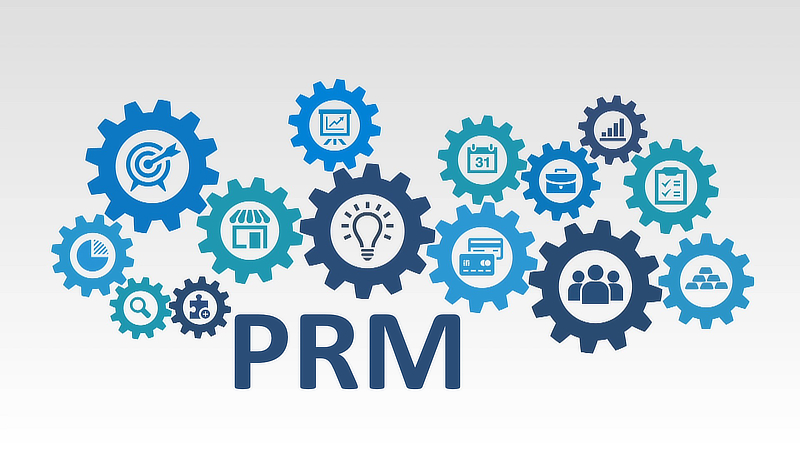Partner Relationship Management (PRM) isn't dead; in fact, it's more foundational than ever. While some experts predicted the demise of PRM, we believe that PRM is becoming essential for running multiple channel programs and executing modern ecosystem strategies.
The reason for pessimism was well-placed. About a decade ago, PRM systems lost the partner “source of truth” to CRM systems such as Salesforce, Microsoft Dynamics, and HubSpot. It made sense that partner intelligence was stored and managed in the same system as end customers in a resell-focused world. Many industry insiders thought PRM, which traditionally was a mile-wide and inch-deep in functionality, would lose to products more feature-rich and targeted to the buyer.
Reports of PRM’s impending death were greatly exaggerated, here’s why:
As more companies shift resources to invest in diversified partner strategies and partner networks, managing an ecosystem of partners is becoming more complex. Diversified routes to market are not only leading to expanding partner bases, but also new collaboration strategies and go-to-market motions with partners.
These complexities have accelerated the need for businesses to measure, manage, nurture and empower an ecosystem of partners more effectively and in more personalized and automated ways. PRM tools are emerging as foundational solutions to manage an ecosystem of partners at scale.
As we look forward to the generational changes that Generative AI (Gen AI) will bring to the partnering space, PRM platforms will be key to building (and tuning) large language models (LLMs) with the vast array of business intelligence built over years with partners. Examples include training, certifications, competencies, incentives, co-marketing, co-selling, and reselling.
The holy grail of partner self-service, powered by Gen AI, will include powerful behavioral data, partner-specific workflows, processes, and business logic. Future partner programs will be hyper-specialized – not just at the partner company level – but the individual contributors inside.
What is PRM?
PRM platforms help automate the various activities associated with managing partner programs and partner lifecycles, from recruitment, to training, to co-selling and co-building, to expansion and renewal. Common features include partner recruitment, onboarding, training, deal registration, communication and collaboration features, performance tracking, and resources to enable co-selling, co-marketing and co-innovation.
For tech vendors, PRMs make managing partner programs, partner relationships, partner communications and partner operations more effective. PRMs also automate manual partner marketing, partner enablement and partner management tasks, enabling individual partner managers to focus more on driving business. These tools often integrate well with other existing business systems such as CRM, marketing automation, content management, ERP and other channel ecosystem tools, making them a valuable platform for cross-functional teams wanting to streamline internal operations and administration.
On the partner side, PRMs act as a one-stop portal to access the resources they need to grow the partnership. PRMs offer streamlined communication between vendors and partners, better lead management tracking and deal registration, and self-serve co-marketing and co-selling support. Ultimately, PRMs enable better visibility, more effective joint go-to-market planning and a more personalized and streamlined relationship.
The PRM landscape
According to Canalys research, the broader ecosystem software industry boasts 233 active companies, generating US$5.3 billion in revenue. This number is projected to jump to $11.8 billion by 2028 as more companies put an emphasis on data-driven ecosystem strategies.
There are 38 PRM players in 2023, delivering US$710 million in PRM revenue. Each PRM on the market has its own strengths, industry and segment focus areas, and are best suited for varying partner strategies and partner program maturity. PRMs are rapidly innovating, and many are vying to become a more comprehensive end-to-end platform.
PRM evaluation criteria
When tech vendors evaluate PRMs, the best choice depends on their partner strategies and existing infrastructure. It's essential to consider factors such as scalability, how it will be used internally and by partners, and specific features relevant to your partner strategy. More specifically, PRMs should enable organizations to grow partner business across complex and diversified partner types and support many go-to-market motions as the business grows.
Ease of integration is also important; PRMs should seamlessly integrate with the other business application tools the organization uses to automate important partner processes. Specifically, PRMs should automatically sync and update with CRM systems to make lead tracking, deal registration, opportunity management and customer management seamless and transparent between partners and account teams. Survey after survey is showing that we now have an integration-first buyer, including this research conducted in a partnership between Canalys, HubSpot, and Partnership Leaders.
Another key area to consider is usability and adoptability. Partner portals help companies scale, but they are only useful if their user interface is intuitive, and they will be adopted and used regularly. PRMs with easier user interfaces and intuitive processes without the need for robust training should be prioritized. Likewise, PRMs are only as good as their content; PRMs with stronger content management capabilities that make it easy to keep resources updated and discoverable by the right users are going to be more useful for partners, long term.
Important PRM evaluation factors include:
- Types of partners: Does the platform support the ecosystem of partners important to your business? Does the platform support the different go-to-market motions important to doing business with varying partner types?
- Scalability: As your partner program grows, can the platform handle increasing numbers of partners and offer tailored experiences to all?
- User experience: How intuitive is the platform’s interface for both internal teams updating content and optimizing partner experiences and for partners to navigate?
- Customizability: How can the platform be customized to meet the needs of your business and partners? Does the platform have a strong network of implementation partners to help design and customize the platform to the needs of the business?
- Reporting and analytics: What type of reporting and analytics does the platform offer to help optimize your partner experiences and partner programs?
- Security and compliance: Does the platform meet security and compliance requirements?
- Training and support: What resources does the platform offer for onboarding internal teams and partner teams?
- Pricing model: How is the PRM price set? Is it per seat? Is it transparent? Will the pricing scale up as you onboard more partners?
- Mobility: Is there mobile access to enable partner managers and partners to manage business on the go?
- Collaboration tools: What tools are available for teams to communicate and collaborate more easily?
- Vendor reputation: Does the PRM vendor have reputable clients?
- Future roadmap: What is the PRM’s road map? Are they evolving the platform to offer support for a holistic ecosystem strategy long-term or are they a point solution? Does the vendor have a strong roadmap and vision for integrating Gen AI to scale key components of channel enablement and management?
- Integrations: How seamless are key integrations with existing business systems?
- Content management capabilities: How easy is it to create, upload, manage and distribute content to partners?
Key PRM players
- 360insights (Whitby, Ontario): 360insights focuses on partner engagement, partner management, channel incentives, data, and partner insights to help vendors better manage partner ecosystems. Its is a large and recognized leader across the globe in managing all aspects of partnering, including PRM.
- Allbound (Atlanta, GA): Allbound makes it easy to collaborate with partners and provides insights to grow partnerships. It found success with growing SaaS companies and is moving into enterprises with more robust functionality.
- AppDirect: (San Francisco, CA): AppDirect’s AppReseller product enables companies to launch and manage reseller and referral partners and includes commerce capabilities. AppDirect also brings deep marketplace leadership into the mix and has acquired several Technology Services Distributors on the telco side.
- Channeltivity (Charlotte, NC): Channeltivity focuses on being a holistic PRM solution for tech companies. A long-time player in PRM, the platform has become very sticky with many vendors.
- Channel Mechanics (Galway, Ireland): Channel Mechanics focuses on automating channel program management and ensuring ease of doing business for partners. It has moved from an enterprise-grade collection of channel tools (and custom development) into a powerful platform for vendors of all sizes.
- Comviva (India): Comviva’s portfolio of digital solutions and platforms includes a PRM solution that helps companies manage channel partners more effectively.
- Impartner (South Jordan, Utah): Impartner PRM optimizes and accelerates partner ecosystems, partner marketing and partner lifecycles with a user-friendly UI and customizable tools. One of the largest players in the PRM market, hundreds of top technology and manufacturing brands trust Impartner with their partner programs.
- Kingdee (Shenzhen, China): Kingdee offers enterprise management solutions, including ERP, cloud services, and PRM tooling.
- Magentrix (Ontario, Canada): Magentrix provides customizable portals, both partner portals and customer portals, to better collaborate with and manage partners. A friendly and scalable UI and UX has earned it high marks from vendors of all sizes.
- MindMatrix (Pittsburgh, Pennsylvania): Mindmatrix’s Bridge platform features PRM functionality and marketing automation with tools for “to”, “through”, “with”, and "for-partner" marketing. This is a unique and capable platform that connects direct selling, channel, and marketing into one platform with great vendor feedback.
- Oracle (Austin, Texas): Oracle offers Oracle PRM in its suite of products, as an integrated partner portal solution for a better partner experience and stronger partner collaboration.
- PartnerStack (Ontario, Canada): PartnerStack focuses on enabling companies to recruit and empower partners, and build, manage and scale channel partner programs. A unique and powerful platform that enables partner referral, attribution, and a huge network of potential partners for all sizes of vendors.
- Salesforce (San Francisco, CA): Salesforce offers Salesforce PRM in its Sales Cloud suite of products. Salesforce PRM includes tools for partner management, deal management, the automation of partner lifecycles, personalized experiences and analytics, with obvious benefits tied to the overall Salesforce platform. It is the largest PRM by revenue and customers and successfully leverages other parts of the company including Tableau, Slack, Trailhead LMS (Learning Management System), and now EinsteinGPT functionality.
- Yonyou (Beijing, China): Yonyou is a major provider of management software solutions in Asia-Pacific, including ERP, CRM, and PRM offerings.
- Zift Solutions (Cary, North Carolina): Zift Solutions is a comprehensive Through-Channel Marketing Automation (TCMA) platform and PRM built to work as one. One of the largest and most powerful PRM’s, the new ZiftOne has hundreds of leading enterprise technology companies as customers.
- Zinfi (Pleasanton, California): Zinfi’s Unified Channel Management platform features modules for Partner Relationship Management, Partner Marketing Management and Collaborative Workflow Management for different types of partners. Zinfi has dozens of large global technology companies as clients and boasts some of the deepest features and functionalities among PRM companies.
PRMs to watch
- CloudCC (Singapore and California): CloudCC is a flexible CRM system that includes partner portal, partner collaboration, partner enablement and partner management capabilities.
- Channelkonnect (Bangalore, India): Channelkonnect provides end-to-end partner relationship management, channel management and influencer management.
- ChannelXperts (Germany): ChannelXperts is a channel management solution featuring ChannelOS, a channel sales and marketing platform, and ChannelPRM, a PRM solution for SMBs that helps get manufacturers up and running.
- Channelyze (London, UK): Channelyze enables companies to manage channel partners more effectively, including vendors, distributors and resellers. A growing company in Europe, it received recognition for its ecosystem-first approach.
- Computer Market Research (Las Vegas, Nevada): Computer Market Research focuses on delivering channel management solutions, including channel partner management, channel marketing management, channel sales management, channel data management, and partner portal capabilities.
- Creatio (Boston, Massachusetts): Creatio is a no-code platform that automates workflows and CRM and offers some integrated PRM functionality.
- Elio (Athens, Greece): Elioplus PRM is a solution designed for software, SaaS and cloud businesses, and offers a free tier to vendors for up to 25 channel partners.
- GorillaToolz (Wantagh, NY): GorillaToolz is a platform to grow, manage and develop partner ecosystems for the IT, manufacturing and healthcare industries.
- Impact.com (Santa Barbara, California): Impact.com focuses on enabling businesses to manage all types of partners, from affiliates to influencers to content publishers and referral partners, across the end-to-end partner lifecycle.
- Inova: At the heart of the biopharma industry, Inova brings together an array of products, data and services to accelerate partnering activities. The platform offers a partner discovery, collaboration, and alliance management portal for biopharma partnerships.
- Kademi (New Zealand): Kademi is a modular PRM platform that enables companies to onboard, engage and accelerate partner performance.
- Kiflo (Paris, France): Kiflo streamlines partner management, enablement, collaboration and communication for SMBs.
- LogicBay (Raleigh, North Carolina): LogicBay is a PRM and LMS focused on the manufacturing industry. LogicBay was recently acquired by The Learning Network.
- MyPRM (Paris, France): MyPRM is a partner portal and management platform that helps companies manage partner relationships more effectively.
- Neocrm (Beijing, China): Neocrm is a CRM solution offering automated business processes from marketing to sales to service, and includes the Neocrm Partner Cloud, an integrated PRM solution.
- PartnerPage (San Francisco, California): PartnerPage focuses on partner directories and marketplaces.
- ParnterPortal.io (New York, New York): PartnerPortal.io is an easy to set up partner portal and PRM tool designed to help earlier-stage companies launch and grow partner programs.
- Pega (Cambridge, Massachusetts): PegaSystems provides business process and CRM solutions, including PRM capabilities built into Sales Automation to drive channel collaboration.
- Rockwell (Australia): Rockwell Information Services develops the Rock Info platform, a PRM with strong enablement functionality in Asia Pacific.
- Scalando (Oslo, Norway): Scalando is a PRM, Ecosystem Management and Orchestration Platform that improves the overall partner experience for technology and SaaS companies.
- Torchlite (Indianapolis, Indiana): Torchlite is a PRM built for growing channel and partnership programs, offering the ability to easily scale quantity and types of partners.
- Zomentum (San Francisco, CA): Zomentum is a sales acceleration and revenue platform built for service providers and other channel partners to automate manual sales, payments and billing processes.
Future of PRM
PRM platforms will continue to evolve to enable diverse partner strategies, incorporate more Gen AI functionality, support more integrations and further automate and personalize partner processes. This will lead to consolidation through acquisitions of niche PRM layers by larger PRM, sales, and MarTech players.
As more business flows through digital marketplaces (US$45 billion and 86% CAGR by 2025 according to Canalys) PRM’s will expand their functionality to support private offers, distributor seller of records, and other co-sell and co-marketing technology through these platforms. PRM’s will also expand functionality to support other emerging routes to market including white labeled (or federated) marketplaces (AppDirect, Mirakl, Vendasta for example), cloud distributors (including Pax8, Ingram CloudBlue, NextGen), technology services distribution (AppDirect, Telarus, Avant, Intellisys for example), and managed services platforms (including. Connectwise, Kaseya/Datto, N-Able). Gen AI is poised to transform PRMs by automating more tasks and workflows, leveraging chatbots for more personalized support and engagement, and facilitating predictive insights and smarter decision making. Centralized data and more robust analytics will provide deeper insights to optimize and manage partnerships, and even entire partner programs. Better and easier personalization, integrations, and customizability will give organizations the flexibility to tailor partner interactions, partner selling and partner management to their unique needs and objectives.
Conclusion
PRMs are foundational to world-class partner organizations. When implemented, integrated and managed correctly, PRMs act as a hub for partner-related data, content and relationships, enhancing visibility, productivity and efficiency. PRM has transformed from a nice to have that manages singular partner strategies, to a necessity for supporting a robust ecosystem and scaling successful channel strategies.


